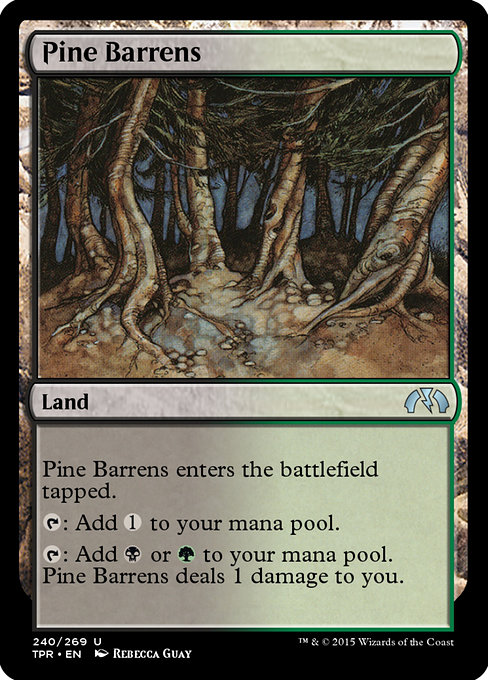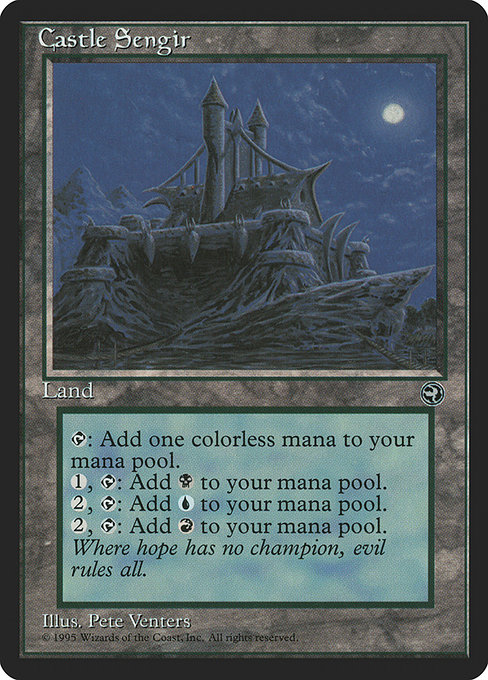The Restless lands from Eldraine are not, by our modern standards, overwhelmingly impressive, and have been derided on social media (although I’m noticing them pop up a fair amount in decklists post-Eldraine). I don’t think that’s an entirely fair assessment: they fix mana, even with a delay, and they are capable of winning a game in a vacuum, which is a high bar for a land to clear. That said, if you’re simply looking for a land to produce Red and Blue in Standard, you can do better–right now, you might add Shivan Reef, Stormcarved Coast, and Mirrex to your decklist before you’d reach for Restless Spire–but in times past, we’d be extraordinarily grateful for the Restless cycle.
Back in Magic’s early days, there were Standard environments where a dual-colored deck’s mana base was “four City of Brass, 10 basic A, 9 basic B.” Once the original duals had rotated out of Standard in October of 1995, our options were more limited–multi-colored decks resorted to Undiscovered Paradise or Gemstone Mine, temporary solutions to a permanent problem of unbalanced mana bases. This was the era of Wasteland, where it was safer to go mono-colored–indeed, there were few payoffs to go multicolored directly; one of my favorite Magic facts is that the game did not print any multicolored cards between Stronghold’s Sliver Queen and Invasion block–from March of 1998 to September of 2000, the gold border was put into mothballs. This was an era where the Invasion taplands (Elfhame Palace) were seen as exciting and tournament-playable, where entire blocks would go by without playable dual lands. Mirrodin and Champions blocks had nine lands capable of producing multiple colors of mana between all six sets, most of which were extremely dubious cards like Mirrodin’s Core and Forgotten Orchard.
This all changed, as so many things did, with Ravnica. The 2005 set (yes, it’s been 18 years as of this month) and its subsequent sets in Guildpact and Dissension gave every color pair an updated version of Beta’s dual lands. The shocklands are some of the most important cards ever printed, seeing universal adoption wherever they’re legal and, in conjunction with fetchlands, giving older formats streamlined mana access. Ravnica’s great innovation was giving every color equal–and quality–mana, from bouncelands (Selesnya Sanctuary) to signets (Boros Signet) to shocklands (Blood Crypt). For those of us used to painlands and Urborg Volcano, shocklands were a statement of purpose: we could now play whatever we wanted without the game implicitly calling us greedy.
This was a refreshing change of pace from the first decade of Magic, which was an era of Stasis and Winter Orb[/mtg_deck] decks and difficult mana–there were many tournaments where you lost to your own deck rather than to your opponent’s, a phenomenon memorialized in Unhinged’s [mtg_card]Mana Screw. No longer would three colored decks be forced to run Treva’s Lair or Tarnished Citadel; the Ravnican model would eventually evolve and give us hits like the M10 checklands, the Scars/Kaladesh fastlands (Concealed Courtyard[/mtg_card), and the Midnight Hunt/Crimson Vow slowlands ([mtg_card]Shipwreck Coast).
It hasn’t all been gravy since Ravnica, though–Wizards developed a perfect cycle of duals in the shocklands, but, capitalism being what it is, they can’t (or believe they can’t) slap the shocks in every set. In almost every set, Wizards instead has to innovate a new cycle or two of dual lands. It’s not a task to relish, particularly with the high bar set by the fetches, shocks, and checklands (Drowned Catacomb), and they do sometimes stumble, but it’s better than I could do. Still, it’s always worth going back through Magic’s history and dredging up the failures to see what’s worked and what hasn’t–why the Worldwake creature-lands defined decks for years, while the Battle for Zendikar block creature-lands mostly flopped. These, then, are the worst cycles of mana-producing lands that Magic has produced:
“Tango” Lands

Set: Battle for Zendikar
You can tell when land cycles aren’t successful when Wizards drops the cycle half finished. In a Standard environment with fetches, Cinder Glade and friends functioned as bad shocklands right at a time when shocklands had rotated out.
Designed to reward players playing basics, these instead allowed decks to splash every color they chose in conjunction with the allied fetchlands and, for months, made us all refer to decks as “Dark Jeskai” or “Moist Jund.” These are a step above the other lands on this list, but they failed at what they were designed to do and contributed to a pretty farcical (albeit fun) Standard.
The Information-Revealers

Sets: Strixhaven, Shadows Over Innistrad
Tournament Magic’s is a game of resource management and two of the most crucial resources are time and information. The game is more complicated than that, but if your velocity drops or you reveal too much information to your opponent, you’re giving them a critical advantage. Revealing a land from your hand is a pretty minimal cost, but it does help your opponent analyze how many options you have, and also leaves these lands as abominable topdecks. Wizards seems pleased with the Snarls/Shadows lands, as they see frequent reprints in Commander decks, but I detest the design personally and think they should be replaced by the Commander Legends four-player lands (Luxury Suite) in those products. In tournament Magic–even when these were legal in Standard–they were a huge disappointment, and the Strixhaven cycle have some of the worst names ever printed on Magic cards.
Depletion Lands

Sets: Ice Age
Modified in Tempest and Champions of Kamigawa
Ice Age had two cycles of ally-colored lands at rare: the initial printing of the memorable painlands (Brushland, etc.) and the lesser-known depletion lands, which are lesser known for very good reasons. Land Cap, Veldt, Lava Tubes, Timberline Ridge, and River Delta are basically lands that get a stun counter put on them every time they tap for mana, meaning you get to access them once every other turn (barring untap shenanigans). In most cases, you’re better off with a Coastal Tower. These inspired Tempest’s and eventually Champions of Kamigawa’s uncommon tap lands (Caldera Lake/Lantern-Lit Graveyard), which could at least tap for colorless without locking down for a turn cycle, but are still unplayable.
Enters-Tapped Painlands

Set: Tempest
These are never-reprinted rares from 1997, are redundant painlands for Commander decks, and are still under two bucks. I doubt even Achelos, Lagoon Mystic is interested, although I remember running Pine Barrens in my first Abzan Commander deck circa Worldwake just out of a lack of options and frugality. Ice Age had given us the ally painlands (Adarkar Wastes, etc.) and enemy-color players had been clamoring for a complete cycle, which we wouldn’t get for another three years. Instead, we got the worst of both worlds in one of Magic’s best sets: lands which cost life to draw mana from, but that still were on a turn delay. Scabland, Skyshroud Forest, Salt Flats, Caldera Lake–I do appreciate that the art and the sinister names add to the oppressiveness of Tempest’s aesthetics, but otherwise, these are justly forgotten.
Filterlands 1.0

Set: Homelands
Modified in Odyssey and Shadowmoor/Eventide
The worst of the worst are Homelands’ cycle of uncommon filter lands. Odyssey’s filterlands (Sungrass Prairie, etc.) and the complete cycle in Shadowmoor/Eventide (Sunken Ruins, etc.) showed us how it’s done so resoundingly that it counts as “assassination” rather than “obsoleting.” But in 1995, if you wanted to play a Grixis deck (thirteen years before that nomenclature existed), you had to resort to Castle Sengir. This cycle has since been completely outpaced by any number of commons–Unknown Shores, Cave of Temptations, and the most recent (and best) iteration in Dominaria United’s Crystal Grotto.
Homelands is, quite justifiably, seen as the nadir of Magic’s early years. They were still figuring things out, from card design to logistics to Wizards’ organization, so I don’t want to belabor it, but the set is full of profoundly misguided cards that even the most nostalgic and charitable among us can’t salvage. The gems in the dross are few and far between–Merchant Scroll, Memory Lapse, Baron Sengir if you’re myopic with nostalgia–and it doesn’t get drossier than the Homelands lands.
Right now, we’re spoiled for choice with nonbasic lands. The painlands are back and still relevant, the New Capenna “triomes” let wild five-color brews thrive in Standard, and the Scars fastlands give ally colors a deserved boost. Limited has embraced common taplands that give dual-colored decks added security and enables hilarious four- or five-color Domain decks, and budget players can snap up cheap cycles like the Restless creaturelands. It’s a buyer’s market for real estate in Standard and Pioneer, and we’re all the better for it–it may have taken a while to get Simic fans on equal footing with Azorius players, but Magic is better when you can actually cast your cards.
Rob Bockman (he/him) is a native of South Carolina who has been playing Magic: the Gathering since Tempest block. A writer of fiction and stage plays, he loves the emergent comedy of Magic and the drama of high-level play. He’s been a Golgari player since before that had a name and is never happier than when he’s able to say “Overgrown Tomb into Thoughtseize,” no matter the format.

